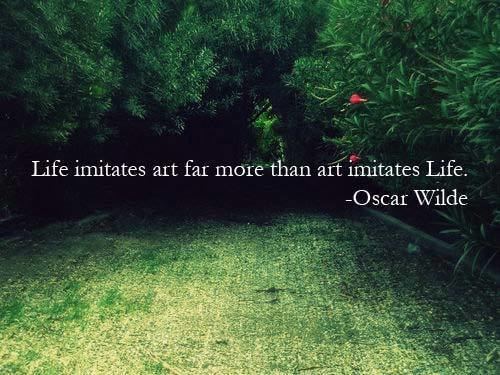 | ||
Life imitating art
Anti-mimesis is a philosophical position that holds the direct opposite of Aristotelian mimesis. Its most notable proponent is Oscar Wilde, who opined in his 1889 essay The Decay of Lying that, "Life imitates Art far more than Art imitates Life". In the essay, written as a Platonic dialogue, Wilde holds that anti-mimesis "results not merely from Life's imitative instinct, but from the fact that the self-conscious aim of Life is to find expression, and that Art offers it certain beautiful forms through which it may realise that energy.".
Contents
- Life imitating art
- Top 10 fascinating cases of life imitating art the real life walter white
- References
What is found in life and nature is not what is really there, but is that which artists have taught people to find there, through art. As in an example posited by Wilde, although there has been fog in London for centuries, one notices the beauty and wonder of the fog because "poets and painters have taught the loveliness of such effects...They did not exist till Art had invented them.".
McGrath places the antimimetic philosophy in a tradition of Irish writing, including Wilde and writers such as Synge and Joyce in a group that "elevate blarney (in the form of linguistic idealism) to aesthetic and philosophical distinction", noting that Terry Eagleton observes an even longer tradition that stretches "as far back in Irish thought as the ninth-century theology of John Scottus Eriugena" and "the fantastic hyperbole of the ancient sagas". Wilde's antimimetic idealism, specifically, McGrath describes to be part of the late nineteenth century debate between Romanticism and Realism. Wilde's antimimetic philosophy has also had influence on later Irish writers, including Brian Friel.
Halliwell asserts that the notion that life imitates art derives from classical notions that can be traced as far back as the writings of Aristophanes of Byzantium, and does not negate mimesis but rather "displace[s] its purpose onto the artlike fashioning of life itself". Halliwell draws a parallel between Wilde's philosophy and Aristophanes' famous question about the comedies written by Menander: "O Menander and Life! Which of you took the other as your model?", noting, however, that Aristophanes was a precursor to Wilde, and not necessarily espousing the positions that Wilde was later to propound.
In George Bernard Shaw's preface to Three Plays he wrote, "I have noticed that when a certain type of feature appears in painting and is admired as beautiful, it presently becomes common in nature; so that the Beatrices and Francescas in the picture galleries of one generation come to life as the parlor-maids and waitresses of the next." He stated that he created the aristocratic characters in Cashel Byron's Profession as unrealistically priggish even without his later understanding that "the real world does not exist...men and women are made by their own fancies in the image of the imaginary creatures in my youthful fictions, only much stupider." Shaw, however, disagreed with Wilde on some points. He considered most attempts by life to imitate art to be reprehensible, in part because the art that people generally chose to imitate was idealistic and romanticized.
An example of life imitating art is that of singer/actress Miley Cyrus, whose role as the famous fictional popstar Hannah Montana in the Disney Channel sitcom of the same name gave rise to her own singing career. Hannah's fictional popularity translated into a real-life fan-base for Cyrus as several singles credited to the character charted on the Billboard Hot 100 (including "The Best of Both Worlds", "Life's What You Make It", "He Could Be the One", etc, though all of the songs were performed by Cyrus) and when she embarked on her sold-out Best of Both Worlds Tour in 2007, where she performed the first set of songs as Hannah Montana and the second set as herself. Cyrus' song "The Climb" was the first song, credited to herself instead of the character, from an official Hannah Montana soundtrack album to become a hit single (peaking at #4 on the Billboard charts, making it her "crossover song" into mainstream pop, while Hoedown Throwdown (off the same soundtrack album) was her first Top 10. Cyrus also performed several duets on the show while in-character as Hannah with real-life singers such as Sheryl Crow, David Archuleta, The Jonas Brothers, Iyaz and her real-life father Billy Ray Cyrus, as well as an unofficial duet with her real-life godmother country singer Dolly Parton.
